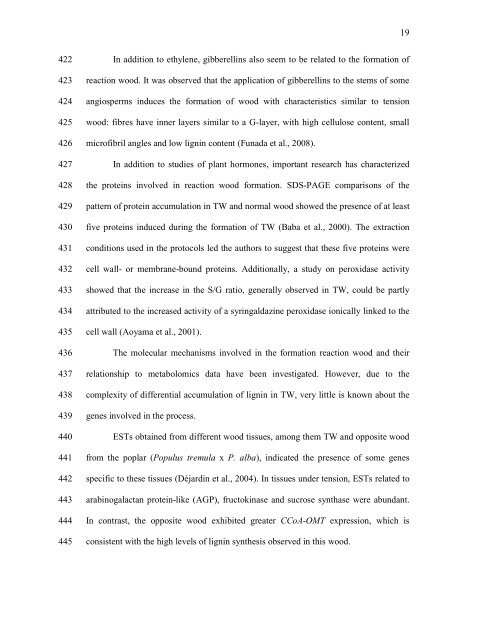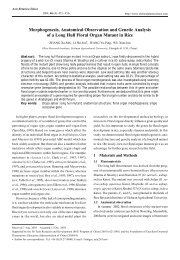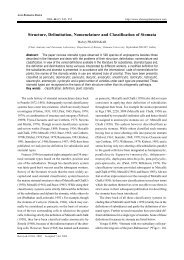Abiotic and biotic stresses and changes in the lignin ... - ResearchGate
Abiotic and biotic stresses and changes in the lignin ... - ResearchGate
Abiotic and biotic stresses and changes in the lignin ... - ResearchGate
Create successful ePaper yourself
Turn your PDF publications into a flip-book with our unique Google optimized e-Paper software.
19<br />
422<br />
423<br />
424<br />
425<br />
426<br />
427<br />
428<br />
429<br />
430<br />
431<br />
432<br />
433<br />
434<br />
435<br />
436<br />
437<br />
438<br />
439<br />
440<br />
441<br />
442<br />
443<br />
444<br />
445<br />
In addition to ethylene, gibberell<strong>in</strong>s also seem to be related to <strong>the</strong> formation of<br />
reaction wood. It was observed that <strong>the</strong> application of gibberell<strong>in</strong>s to <strong>the</strong> stems of some<br />
angiosperms <strong>in</strong>duces <strong>the</strong> formation of wood with characteristics similar to tension<br />
wood: fibres have <strong>in</strong>ner layers similar to a G-layer, with high cellulose content, small<br />
microfibril angles <strong>and</strong> low lign<strong>in</strong> content (Funada et al., 2008).<br />
In addition to studies of plant hormones, important research has characterized<br />
<strong>the</strong> prote<strong>in</strong>s <strong>in</strong>volved <strong>in</strong> reaction wood formation. SDS-PAGE comparisons of <strong>the</strong><br />
pattern of prote<strong>in</strong> accumulation <strong>in</strong> TW <strong>and</strong> normal wood showed <strong>the</strong> presence of at least<br />
five prote<strong>in</strong>s <strong>in</strong>duced dur<strong>in</strong>g <strong>the</strong> formation of TW (Baba et al., 2000). The extraction<br />
conditions used <strong>in</strong> <strong>the</strong> protocols led <strong>the</strong> authors to suggest that <strong>the</strong>se five prote<strong>in</strong>s were<br />
cell wall- or membrane-bound prote<strong>in</strong>s. Additionally, a study on peroxidase activity<br />
showed that <strong>the</strong> <strong>in</strong>crease <strong>in</strong> <strong>the</strong> S/G ratio, generally observed <strong>in</strong> TW, could be partly<br />
attributed to <strong>the</strong> <strong>in</strong>creased activity of a syr<strong>in</strong>galdaz<strong>in</strong>e peroxidase ionically l<strong>in</strong>ked to <strong>the</strong><br />
cell wall (Aoyama et al., 2001).<br />
The molecular mechanisms <strong>in</strong>volved <strong>in</strong> <strong>the</strong> formation reaction wood <strong>and</strong> <strong>the</strong>ir<br />
relationship to metabolomics data have been <strong>in</strong>vestigated. However, due to <strong>the</strong><br />
complexity of differential accumulation of lign<strong>in</strong> <strong>in</strong> TW, very little is known about <strong>the</strong><br />
genes <strong>in</strong>volved <strong>in</strong> <strong>the</strong> process.<br />
ESTs obta<strong>in</strong>ed from different wood tissues, among <strong>the</strong>m TW <strong>and</strong> opposite wood<br />
from <strong>the</strong> poplar (Populus tremula x P. alba), <strong>in</strong>dicated <strong>the</strong> presence of some genes<br />
specific to <strong>the</strong>se tissues (Déjard<strong>in</strong> et al., 2004). In tissues under tension, ESTs related to<br />
arab<strong>in</strong>ogalactan prote<strong>in</strong>-like (AGP), fructok<strong>in</strong>ase <strong>and</strong> sucrose synthase were abundant.<br />
In contrast, <strong>the</strong> opposite wood exhibited greater CCoA-OMT expression, which is<br />
consistent with <strong>the</strong> high levels of lign<strong>in</strong> syn<strong>the</strong>sis observed <strong>in</strong> this wood.







